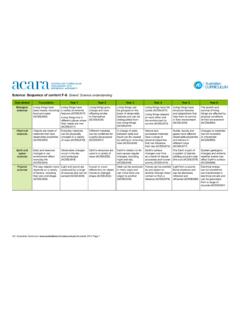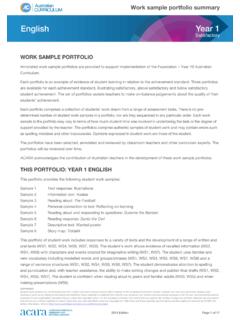Transcription of Shape of the Australian Curriculum v4
1 November 2010. The Shape of the Australian Curriculum Version October 2012. Australian Curriculum , Assessment and Reporting Authority 2013. This work is copyright. You may download, display, print and reproduce this material in unaltered form only (retaining this notice) for your personal, non-commercial use or use within your organisation. All other rights are reserved. Requests and inquiries concerning reproduction and rights should be addressed to: ACARA Copyright Administration, ACARA. Level 10, 255 Pitt Street Sydney NSW 2000. Amendment history Date Version Comment May 2009 Approved by the Interim National Curriculum Board in May 2009 to guide the development of the first phase of the Australian Curriculum (English, mathematics, science and history). October 2010 Updated to support implementation of the Foundation to Year 10 Australian Curriculum for English, mathematics, science and history, to provide the context for the next stage of development of the Foundation to Year 12.
2 Curriculum and to promote ongoing discussion about the Shape of the Australian Curriculum as a whole. Approved by the ACARA Board 26 October 2010. October 2011 The F 10 Curriculum Position paper on the whole Curriculum , achievement standards and support for students with disability was endorsed by the Ministerial Council in July 2011 and informed the revision of The Shape of the Australian Curriculum October 2012 Updated to include information about the Shape of the senior secondary Curriculum and additional advice on how the Australian Curriculum meets the needs of the diverse range of students in Australian schools. 1. The Shape of the Australian Curriculum : Version Contents Purpose .. 3. Preamble .. 4. An Australian Curriculum .. 5. Rationale .. 5. Goals of Education .. 8. Development of the Australian Curriculum .. 10. Propositions shaping the Australian 10. Curriculum development process .. 11. Scope of the Australian Curriculum .
3 13. Dimensions of the Australian 15. The Curriculum across the years of schooling .. 19. The diversity of learners .. 20. Curriculum content .. 22. Organisation of the Australian Curriculum F-10 .. 22. learning area knowledge, understanding and skills .. 22. General capabilities .. 23. Cross- Curriculum priorities .. 23. Development of the F-10 Curriculum on a year-by-year or bands-of-school-years basis .. 24. Organisation of the senior secondary Australian Curriculum .. 24. Quality assurance and review of the Australian Curriculum .. 26. Teaching, assessing and 27. Towards a world-class Australian Curriculum .. 28. 2. The Shape of the Australian Curriculum : Version Purpose 1. The Shape of the Australian Curriculum provides background to the development of and for the implementation of the Australian Curriculum . 2. The first Shape of the Australian Curriculum (May 2009) was written to guide the development of the first phase of the Australian Curriculum (English, mathematics, science and history).
4 It was approved by the Ministerial Council in September 2009. Subsequent versions were approved by Ministers in December 2010 (Version ) and October 2011 (Version ). 3. The Shape of the Australian Curriculum : Version Preamble 3. The Australian Curriculum , Assessment and Reporting Authority (ACARA) is responsible for: a national Curriculum from Foundation to Year 12 in specified learning areas a national assessment program aligned to the national Curriculum that measures students' progress a national data collection and reporting program that supports: - analysis, evaluation, research and resource allocation - accountability and reporting on schools - broader national achievement. 4. As part of its initial charter, ACARA was asked to commence Curriculum development for English, mathematics, science and history. A second phase of work was authorised involving the development of an Australian Curriculum in geography, languages and the Arts.
5 Subsequently, Australian education ministers agreed that a third phase of Curriculum development will focus on health and physical education, information and communication technology, design and technology, economics and business, and civics and citizenship. 5. The establishment of ACARA can be seen as an outcome of many years of national collaboration in education. Twenty years ago, the Ministerial Council on Education, Employment, Training and Youth Affairs produced a collaborative statement on goals for schooling: the Hobart Declaration of 1989. Both the Hobart Declaration and the 1999 Adelaide Declaration authorised and stimulated the national effort. 6. The Curriculum development work of ACARA is guided by the Melbourne Declaration on Educational Goals for Young Australians, adopted by the Ministerial Council in December 2008. The Melbourne Declaration emphasises the importance of knowledge, understanding and skills of learning areas, general capabilities and cross- Curriculum priorities as the basis for a Curriculum designed to support 21st century learning .
6 4. The Shape of the Australian Curriculum : Version An Australian Curriculum Rationale 7. All Australian governments have committed to the goals of the Melbourne Declaration, which are that Australian schooling promotes equity and excellence; and that all young Australians become successful learners, confident and creative individuals, and active and informed citizens. Promoting world-class Curriculum and assessment is one of eight interrelated areas for action designed to achieve the Melbourne Declaration goals. 8. The rationale for introducing an Australian Curriculum centres on improving the quality, equity and transparency of Australia's education system. Quality an Australian Curriculum will contribute to the provision of a world- class education in Australia by setting out the knowledge, understanding and skills needed for life and work in the 21st century and by setting common high standards of achievement across the country. Equity an Australian Curriculum will provide a clear, shared understanding of what young people should be taught and the quality of learning expected of them, regardless of their circumstances, the type of school that they attend or the location of their school.
7 9. Education plays a critical role in shaping the lives of the nation's future citizens. To play this role effectively, the intellectual, personal, social and educational needs of young Australians must be addressed at a time when ideas about the goals of education are changing and will continue to evolve. 10. At the 60th Australian Education Council meeting held in Hobart in April 1989, education ministers produced a collaborative statement on goals for schooling: the Hobart Declaration. This statement was updated in 1999 as the Adelaide Declaration. In 2008, ministers nominated five major developments that, over the 20-year period, had changed the ways in which people interacted with each other and thought about the purposes of schooling. These changes were set out in the Melbourne Declaration on Educational Goals for Young Australians (see Box 1). 5. The Shape of the Australian Curriculum : Version An Australian Curriculum Box 1: Changes over the period 1989-2008 with implications for education Global integration and international mobility have increased rapidly in the past decade.
8 As a consequence, new and exciting opportunities for Australians are emerging. This heightens the need to nurture an appreciation of, and respect for, social, cultural and religious diversity, and a sense of global citizenship. India, China and other Asian nations are growing and their influence on the world is increasing. Australians need to become Asia literate' by building strong relationships with Asia. Globalisation and technological change are placing greater demands on education and skill development in Australia, and the nature of jobs available to young Australians is changing faster than ever. Skilled jobs now dominate jobs growth, and people with university or vocational education and training qualifications fare much better in the employment market than early school-leavers. To maximise their opportunities for healthy, productive and rewarding futures, Australia's young people must be encouraged not only to complete secondary education, but also to proceed into further training or education.
9 Complex environmental, social and economic pressures, such as climate change, that extend beyond national borders pose unprecedented challenges, requiring countries to work together in new ways. To meet these challenges, Australians must be able to comprehend and use scientific concepts and principles, and approach problem solving in new and creative ways. Rapid and continuing advances in information and communication technologies (ICT) are changing the ways people share, use, develop and process information and technology, and young people need to be highly skilled in ICT. While schools already employ these technologies in learning , there is a need to increase their effectiveness significantly over the next decade. Ministerial Council on Education, Employment, Training and Youth Affairs, Melbourne Declaration on Educational Goals for Young Australians, December 2008, 6. The Shape of the Australian Curriculum : Version An Australian Curriculum 11.
10 Education must not only respond to these remarkable changes but also, as far as possible, anticipate the conditions in which young Australians will need to function as individuals, citizens and workers when they complete their schooling. These future conditions are distant and difficult to predict. It is expected that almost all young Australians who begin primary school in 2011 will continue their initial education until 2022. Many will go on to further education or training through to the mid-2020s and later. Young people will need a wide and adaptive set of knowledge, understanding and skills and to meet the changing expectations of society and to contribute to the creation of a more productive, sustainable and just society. 12. An Australian Curriculum in the 21st century needs to acknowledge the changing ways in which young people will learn and the challenges that will continue to Shape their learning in the future. The Curriculum is important in setting out what will be taught, what students need to learn and the expected quality of that learning .









